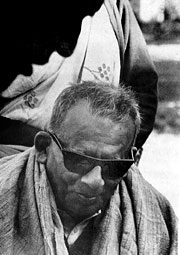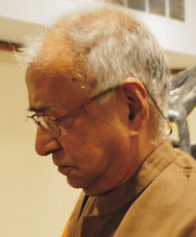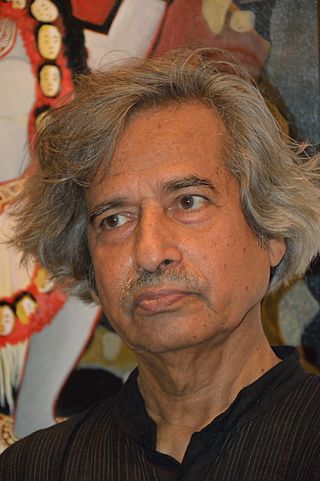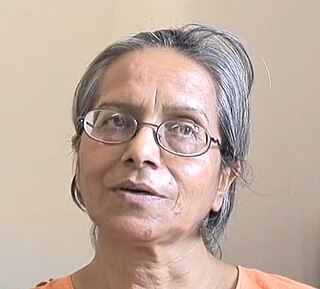
Tebhaga movement (1946–1947) was significant peasant agitation, initiated in Bengal by the All India Kisan Sabha of peasant front of the Communist Party of India.

Benode Behari Mukherjee was an Indian artist from West Bengal state. Mukherjee was one of the pioneers of Indian modern art and a key figure of Contextual Modernism. He was one of the earliest artists in modern India to take up to murals as a mode of artistic expression. All his murals depict a subtle understanding of environmental through pioneering architectural nuances.

Mukul Chandra Dey was one of five children of Purnashashi Devi and Kula Chandra Dey. He was a student of Rabindranath Tagore's Santiniketan and is considered as a pioneer of drypoint-etching in India. The entire family of Mukul Dey had artistic talents, the brother Manishi Dey was a well-known painter, and his two sisters, Annapura and Rani Chanda, were accomplished in arts and crafts as well.

Edmond Casarella was an American printmaker, painter, and sculptor based in the New York metropolitan area. He developed the innovative use of a layered cardboard printing matrix that could be carved like a woodcut, enabling the inexpensive creation of large-scale works.

Krishna Reddy was an Indian master printmaker, sculptor, and teacher. He was considered a master intaglio printer and known for viscosity printing.
Sankho Chaudhuri was an Indian sculptor, and a noted figure in the art scene of India. (Although named Naranarain in due family tradition, he was more widely known by his pet name Sankho). Ram Kinker Baij was his teacher. He began close to cubism and then was influenced by István Beöthy, whom he had met in Paris. His themes have included the female figure and wildlife. He has worked in a wide range of media and produced large-scale reliefs and mobiles.

Kalpathi Ganpathi "K.G." Subramanyan was an Indian artist. He was awarded the Padma Vibhushan in 2012.
Kalal Laxma Goud is an Indian painter, printmaker and draughtsman. He works in variety of mediums including etching, gouache, pastel, sculpture, and glass painting. He is best known for his early drawings that depict eroticism in a rural context, and also for the originality and quality of his etchings and aquatints.

Jogen Chowdhury is an eminent Indian painter and considered an important painter of 21st century India. He lives and works in Santiniketan. He graduated from the Government College of Art & Craft, Kolkata and subsequently at École nationale supérieure des Beaux-Arts, Paris in 1967. He has immense contribution in inspiring young artists of India. Jogen Chowdhury had developed his individual style after his return from Paris. His most famous paintings are in ink, water colour and pastel. He has painted in oil medium as well.
Harendra Narayan Das, better known as Haren Das, was a highly respected artist in India who worked almost exclusively in printmaking mediums. His work included engravings, linocuts, etchings, and lithographs, though he is most remembered for the technical skill of his woodcuts and wood engravings.

Anupam Sud is an artist who lives and works in Mandi, a small community on the outskirts of New Delhi. She was born in Punjab, though she spent much of her youth in the former British summer capital of Simla in Himachal Pradesh. Coming from a conservative family, her choice of an academic career and artistic pursuits over an arranged marriage was both brave and rare.

Chittaprosad Bhattacharya was an Indian political artist of the mid-20th century. He preferred watercolor and printmaking, avoiding oil on canvas.
Sukanta Basu is a non-representational painter of Indian origin, who has also worked as an art conservator. He lives and paints in Kolkata, West Bengal. While his early works were mainly oils and sketchy portraits, Basu later worked with acrylics on canvas and occasionally pencil or charcoal drawings.

Raman Siva Kumar, known as R. Siva Kumar, is an Indian contemporary art historian, art critic, and curator. His major research has been in the area of early Indian modernism with special focus on the Santiniketan School. He has written several important books, lectured widely on modern Indian art and contributed articles to prestigious international projects such as the Art Journal, Grove Art Online or The Dictionary of Art, Oxford University Press.

Kala Bhavana is the fine arts faculty of Visva-Bharati University, in Shantiniketan, India. It is an institution of education and research in visual arts, founded in 1919, it was established by Nobel laureate Rabindranath Tagore.
Tom Vattakuzhy is an Indian painter, Printmaker, and Illustrator. His works have been cited for their use of light effects.
Dinkar Kowshik (1918-2011) was an influential Indian painterand educator. As principal of Kala Bhavana at Santiniketan, he reshaped it for contemporary art practices.
Reba Hore (1926–2008) was an Indian artist and activist. She has worked in various mediums ranging from water colors, mixed media, oil paints, pastels to terracotta. Her artworks were spontaneous, deeply personal and rooted in her daily life experiences. She was the wife of Somnath Hore, an accomplished sculptor and print maker himself.
Leela Mukerji was an Indian artist; her artwork includes paintings, drawings, sculpture, printmaking and murals. Works by her are in the collection of the National Gallery of Modern Art, New Delhi.

Sanat Kar was a prominent Indian painter and printmaker. He is one of the pioneers of modern Indian printmaking and is known for his experiments with wood intaglio.












